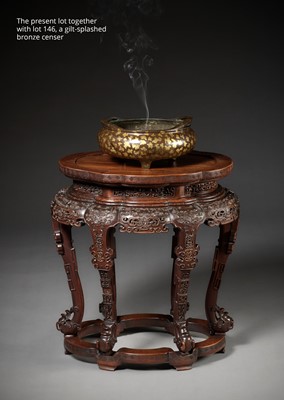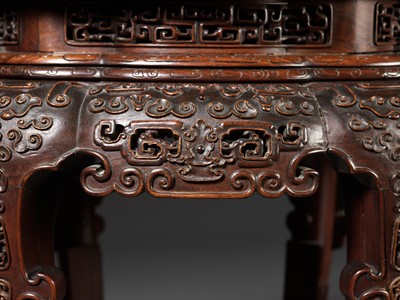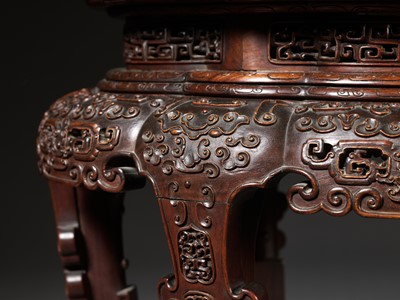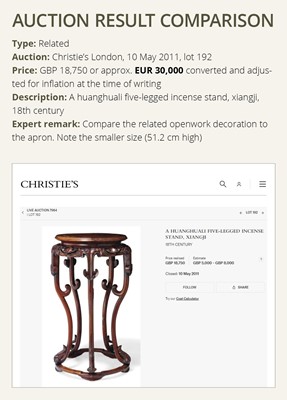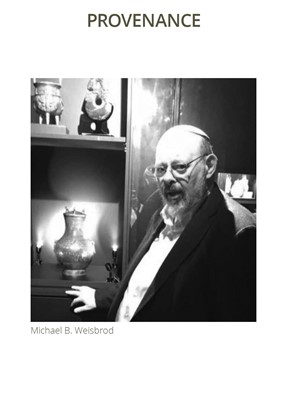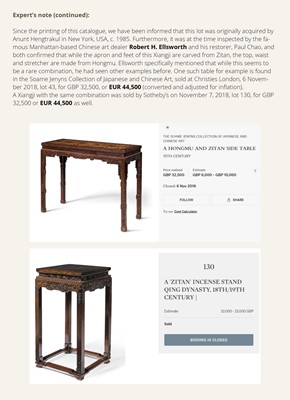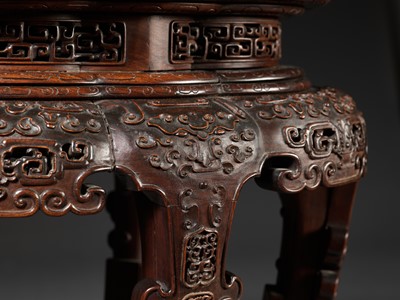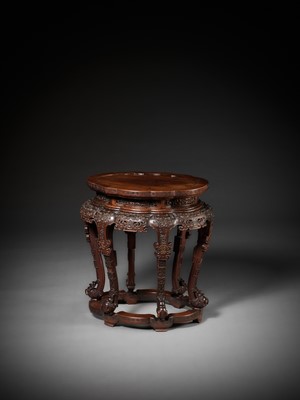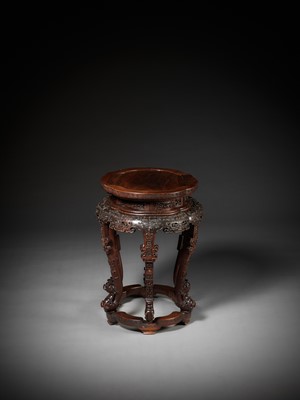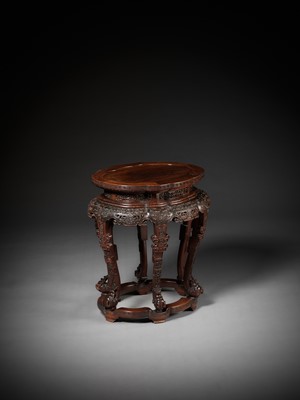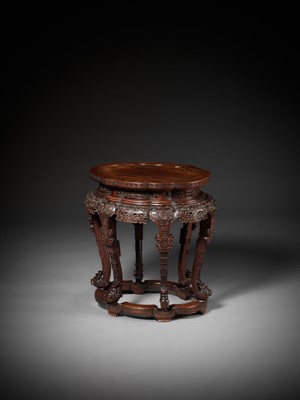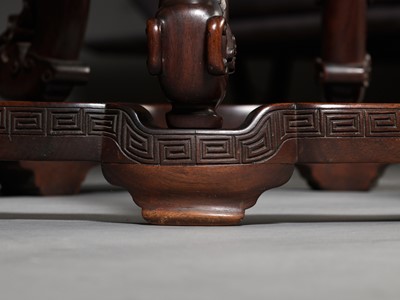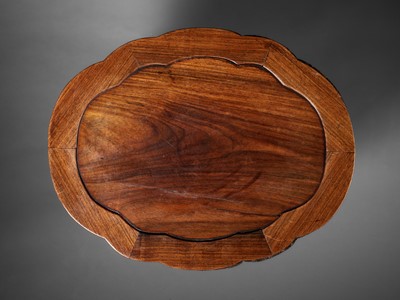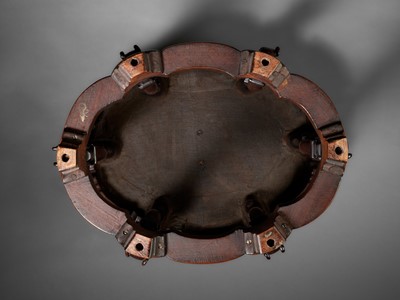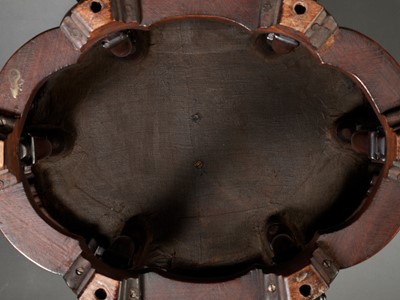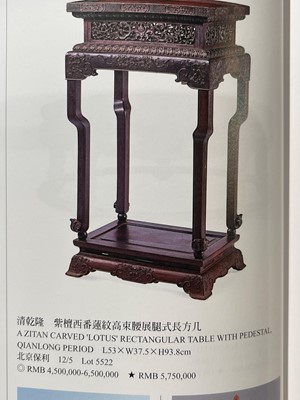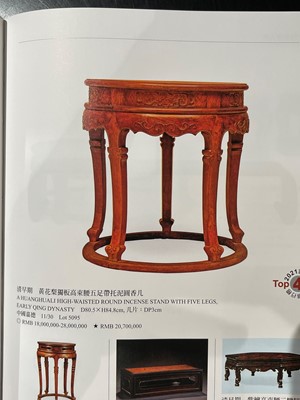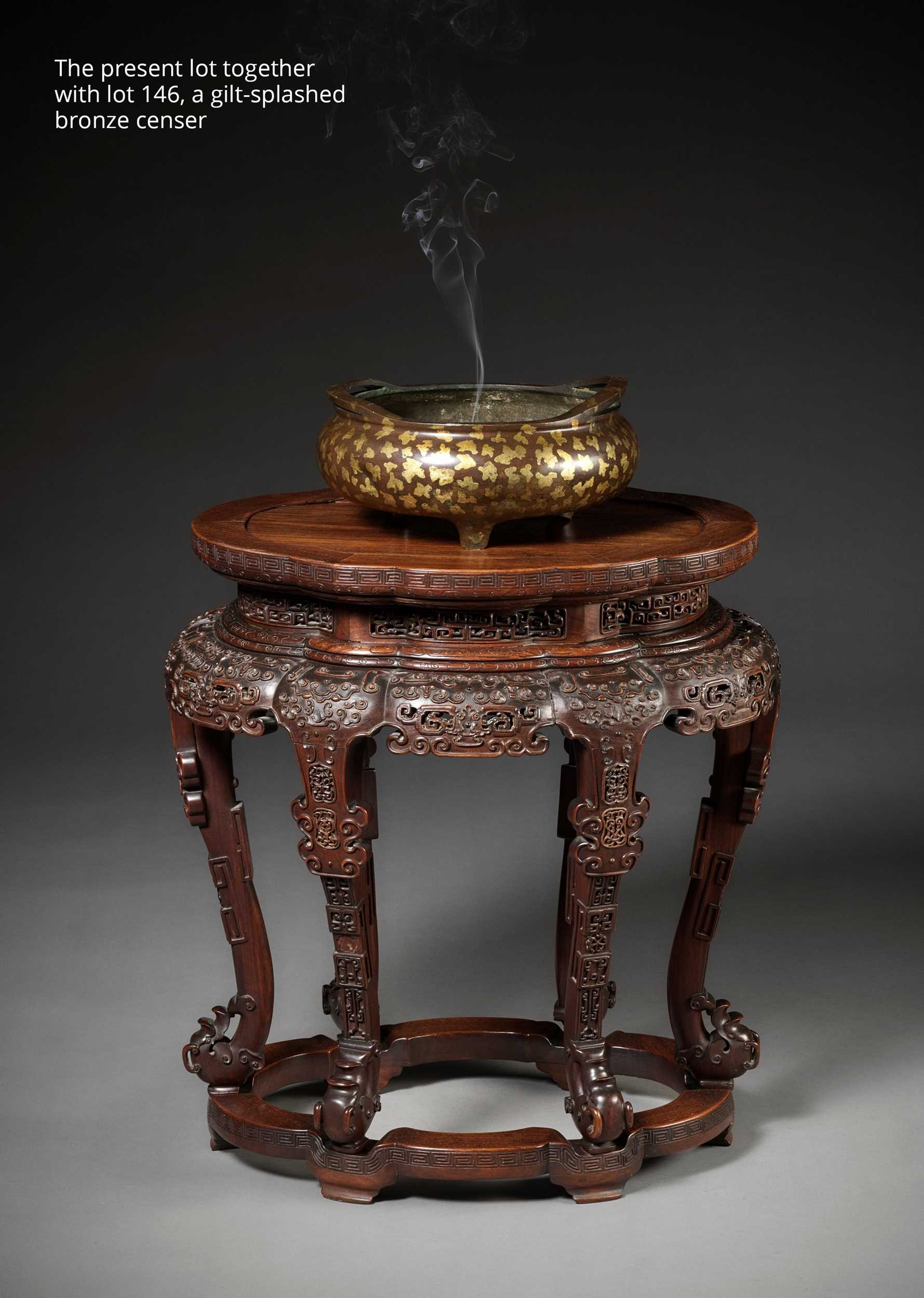29th Sep, 2022 13:00
DAY 1 - TWO-DAY AUCTION - Fine Chinese Art / 中國藝術集珍 / Buddhism & Hinduism
19
A ‘TAOTIE’ INCENSE STAND, XIANGJI, QING DYNASTY
清代饕餮紋香几
Sold for €20,800
including Buyer's Premium
China, 1644-1912. Of roughly oval, foliate-lobed form, the top carved to the sides with key-fret and inset with a conforming panel above the recessed waist carved with reticulated kui scroll panels, supported on an intricately carved apron decorated with taotie masks, pierced designs, and cloud scroll, the six elaborate cabriole legs carved with further archaistic scroll motifs, raised on a stretcher carved with key-fret to the sides.
Provenance: From the private collection of Michael B. Weisbrod, New York, USA. Michael B. Weisbrod is a noted scholar of Chinese art, who has published extensively on the subject over a time span of more than 50 years. In 1972, Michael joined his father Dr. Gerald Weisbrod’s Asian art gallery in Toronto, Canada. The father-and-son team opened their New York location on Madison Avenue in 1977, and during the next 45 years the gallery held a significant number of exhibitions, selling to museums and private collectors across the globe, eventually adding further locations in Shanghai and Hong Kong.
Condition: Good condition with old wear, expected age cracks, small losses, minor chips, light scratches. There is a remote possibility that the apron and cabriole legs are of a significantly earlier date than the top, waist, and stretcher which date from the mid to late Qing dynasty. Fine, naturally grown patina overall.
Dimensions: Height 69 cm, Width 60 cm (the tabletop)
Incense stands, both in lacquer and hardwood, are seen in a variety of forms, including round, square, foliate, hexagonal and octagonal and are constructed with between three and six legs. Round lacquer incense stands appear to be the most commonly published examples and are depicted in woodblock prints from the Ming dynasty. The Palace Museum, Beijing has four examples ranging in date from the Xuande period (1426-1435) to the early Qing dynasty, illustrated in The Complete Collection of Treasures of the Palace Museum, Furniture of the Ming and Qing Dynasties, 2002, nos. 162, 165, 166, and 169.
Expert’s note: The timber from which this incense stand was made is rosewood (Dalbergia). It has a lovely grain and fine patina. While some houses refer to this type of wood as huanghuali, in our opinion and due to some subtle differences, it may also be accurate to refer to it as hongmu. The stand has been created by a highly skilled craftsman and the quality of the carving is excellent, most remarkably around the apron and cabriole legs.
Expert’s note (continued): Since the printing of this catalogue, we have been informed that this lot was originally acquired by Anunt Hengtrakul in New York, USA, c. 1985. Furthermore, it was at the time inspected by the famous Manhattan-based Chinese art dealer Robert H. Ellsworth and his restorer, Paul Chao, and both confirmed that while the apron and feet of this Xiangji are carved from Zitan, the top, waist and stretcher are made from Hongmu. Ellsworth specifically mentioned that while this seems to be a rare combination, he had seen other examples before. One such table for example is found in the Soame Jenyns Collection of Japanese and Chinese Art, sold at Christies London, 6 November 2018, lot 43, for GBP 32,500, or EUR 44,500 (converted and adjusted for inflation). A Xiangji with the same combination was sold by Sotheby’s on 7 November 2018, lot 130, for GBP 32,500 or EUR 44,500 as well.
Literature comparison:
Compare a related xiangji, also supported on six legs, in the Palace Museum, Beijing, illustrated in Wang Shixiang, Classic Chinese Furniture, London, 1986, pl. 76.
Auction result comparison:
Type: Related
Auction: Christie’s London, 10 May 2011, lot 192
Price: GBP 18,750 or approx. EUR 30,000 converted and adjusted for inflation at the time of writing
Description: A huanghuali five-legged incense stand, xiangji, 18th century
Expert remark: Compare the related openwork decoration to the apron. Note the smaller size (51.2 cm high)
清代饕餮紋香几
中國,1644-1912年。六足香几,高束腰,造型優美典雅、線條高挑流暢,頂部刻有雷紋,並在束腰部上方嵌有一個面板,雕刻有網狀夔龍紋,牙條飾有饕餮面具,鏤空雕刻,捲雲紋,六條三彎腿上雕刻著卷葉紋,圓形托泥帶龜腳。
來源:美國紐約Michael B. Weisbrod私人收藏。Michael B. Weisbrod是一位著名的中國藝術學者,他在 50 多年的時間裡就該主題發表了大量著作。1972 年,Michael加入了他父親 Gerald Weisbrod 博士在加拿大多倫多的亞洲藝術藝廊。這對父子團隊於 1977 年在麥迪遜大道開設了他們的紐約分館,在接下來的 45 年裡,藝廊舉辦了大量展覽,向全球的博物館和私人收藏家出售作品,最終還在上海和香港開辦分店。
品相:狀況良好,老化裂紋、小缺損、輕微碎屑、輕微劃痕。牙條和腿的年代可能早於其他部位。整體包漿細膩。
尺寸:高69 厘米,寬 60 厘米
漆木和硬木香几有多種形式,包括圓形、方形、葉狀、六角形和八角形,由三到六足。 圓形漆香几似乎是最常見的例子,並在明代的木版畫中有所記錄。北京故宮博物院收藏了宣德年間(1426-1435)至清初的四件藏品,見《故宫博物院藏文物珍品全集·明清家具》2002年,圖162、165、166 和 169。
專家注釋:製作這個香几的木材是紅木(黃檀)。它有美麗的紋理和細膩的包漿。雖然有些有人將它稱為黃花梨,因爲還有一些細微的差異,將其稱為紅木也可能是準確的。香几由技藝精湛的工匠製作而成,雕刻質量非常出色。
專家注釋:在圖錄印出後,我們被通知此拍品於大約1985年由美國紐約 Anunt Hengtrakul購入。此外,當時曼哈頓著名的中國藝術品經銷商Robert H. Ellsworth和他的修復師Paul Chow對它進行了檢查,兩人都確認,雖然此香几牙條和足部是用紫檀雕刻的,但頂部、腰部和底部是用紅木製作的。Ellsworth特別提到,雖然這似乎是一個罕見的組合,但他以前也見過其他例子。一件相似的方桌收藏於Soame Jenyns Collection of Japanese and Chinese Art,拍出於倫敦佳士得,2018年11月6日,lot 43,售於GBP 32,500 (相當於今日EUR 44,500)。一件有相似組的香几,見倫敦蘇富比,2018年11月7日,lot 130,售於GBP 32,500(相當於今日EUR 44,500) 。
文獻比較:
比較一件相近的六足香几,收藏於北京故宮博物院,見Wang Shixiang,《Classic Chinese Furniture》,倫敦,1986年,編號76。
拍賣結果比較:
形制:相近
拍賣:倫敦佳士得,2011年5月10日,lot 192
價格:GBP 18,750(相當於今日EUR 30,000)
描述:十八世紀黃花梨五足香几
專家評論:比較相近的鏤空牙條雕刻。請注意尺寸較小(高51.2 厘米)。
China, 1644-1912. Of roughly oval, foliate-lobed form, the top carved to the sides with key-fret and inset with a conforming panel above the recessed waist carved with reticulated kui scroll panels, supported on an intricately carved apron decorated with taotie masks, pierced designs, and cloud scroll, the six elaborate cabriole legs carved with further archaistic scroll motifs, raised on a stretcher carved with key-fret to the sides.
Provenance: From the private collection of Michael B. Weisbrod, New York, USA. Michael B. Weisbrod is a noted scholar of Chinese art, who has published extensively on the subject over a time span of more than 50 years. In 1972, Michael joined his father Dr. Gerald Weisbrod’s Asian art gallery in Toronto, Canada. The father-and-son team opened their New York location on Madison Avenue in 1977, and during the next 45 years the gallery held a significant number of exhibitions, selling to museums and private collectors across the globe, eventually adding further locations in Shanghai and Hong Kong.
Condition: Good condition with old wear, expected age cracks, small losses, minor chips, light scratches. There is a remote possibility that the apron and cabriole legs are of a significantly earlier date than the top, waist, and stretcher which date from the mid to late Qing dynasty. Fine, naturally grown patina overall.
Dimensions: Height 69 cm, Width 60 cm (the tabletop)
Incense stands, both in lacquer and hardwood, are seen in a variety of forms, including round, square, foliate, hexagonal and octagonal and are constructed with between three and six legs. Round lacquer incense stands appear to be the most commonly published examples and are depicted in woodblock prints from the Ming dynasty. The Palace Museum, Beijing has four examples ranging in date from the Xuande period (1426-1435) to the early Qing dynasty, illustrated in The Complete Collection of Treasures of the Palace Museum, Furniture of the Ming and Qing Dynasties, 2002, nos. 162, 165, 166, and 169.
Expert’s note: The timber from which this incense stand was made is rosewood (Dalbergia). It has a lovely grain and fine patina. While some houses refer to this type of wood as huanghuali, in our opinion and due to some subtle differences, it may also be accurate to refer to it as hongmu. The stand has been created by a highly skilled craftsman and the quality of the carving is excellent, most remarkably around the apron and cabriole legs.
Expert’s note (continued): Since the printing of this catalogue, we have been informed that this lot was originally acquired by Anunt Hengtrakul in New York, USA, c. 1985. Furthermore, it was at the time inspected by the famous Manhattan-based Chinese art dealer Robert H. Ellsworth and his restorer, Paul Chao, and both confirmed that while the apron and feet of this Xiangji are carved from Zitan, the top, waist and stretcher are made from Hongmu. Ellsworth specifically mentioned that while this seems to be a rare combination, he had seen other examples before. One such table for example is found in the Soame Jenyns Collection of Japanese and Chinese Art, sold at Christies London, 6 November 2018, lot 43, for GBP 32,500, or EUR 44,500 (converted and adjusted for inflation). A Xiangji with the same combination was sold by Sotheby’s on 7 November 2018, lot 130, for GBP 32,500 or EUR 44,500 as well.
Literature comparison:
Compare a related xiangji, also supported on six legs, in the Palace Museum, Beijing, illustrated in Wang Shixiang, Classic Chinese Furniture, London, 1986, pl. 76.
Auction result comparison:
Type: Related
Auction: Christie’s London, 10 May 2011, lot 192
Price: GBP 18,750 or approx. EUR 30,000 converted and adjusted for inflation at the time of writing
Description: A huanghuali five-legged incense stand, xiangji, 18th century
Expert remark: Compare the related openwork decoration to the apron. Note the smaller size (51.2 cm high)
清代饕餮紋香几
中國,1644-1912年。六足香几,高束腰,造型優美典雅、線條高挑流暢,頂部刻有雷紋,並在束腰部上方嵌有一個面板,雕刻有網狀夔龍紋,牙條飾有饕餮面具,鏤空雕刻,捲雲紋,六條三彎腿上雕刻著卷葉紋,圓形托泥帶龜腳。
來源:美國紐約Michael B. Weisbrod私人收藏。Michael B. Weisbrod是一位著名的中國藝術學者,他在 50 多年的時間裡就該主題發表了大量著作。1972 年,Michael加入了他父親 Gerald Weisbrod 博士在加拿大多倫多的亞洲藝術藝廊。這對父子團隊於 1977 年在麥迪遜大道開設了他們的紐約分館,在接下來的 45 年裡,藝廊舉辦了大量展覽,向全球的博物館和私人收藏家出售作品,最終還在上海和香港開辦分店。
品相:狀況良好,老化裂紋、小缺損、輕微碎屑、輕微劃痕。牙條和腿的年代可能早於其他部位。整體包漿細膩。
尺寸:高69 厘米,寬 60 厘米
漆木和硬木香几有多種形式,包括圓形、方形、葉狀、六角形和八角形,由三到六足。 圓形漆香几似乎是最常見的例子,並在明代的木版畫中有所記錄。北京故宮博物院收藏了宣德年間(1426-1435)至清初的四件藏品,見《故宫博物院藏文物珍品全集·明清家具》2002年,圖162、165、166 和 169。
專家注釋:製作這個香几的木材是紅木(黃檀)。它有美麗的紋理和細膩的包漿。雖然有些有人將它稱為黃花梨,因爲還有一些細微的差異,將其稱為紅木也可能是準確的。香几由技藝精湛的工匠製作而成,雕刻質量非常出色。
專家注釋:在圖錄印出後,我們被通知此拍品於大約1985年由美國紐約 Anunt Hengtrakul購入。此外,當時曼哈頓著名的中國藝術品經銷商Robert H. Ellsworth和他的修復師Paul Chow對它進行了檢查,兩人都確認,雖然此香几牙條和足部是用紫檀雕刻的,但頂部、腰部和底部是用紅木製作的。Ellsworth特別提到,雖然這似乎是一個罕見的組合,但他以前也見過其他例子。一件相似的方桌收藏於Soame Jenyns Collection of Japanese and Chinese Art,拍出於倫敦佳士得,2018年11月6日,lot 43,售於GBP 32,500 (相當於今日EUR 44,500)。一件有相似組的香几,見倫敦蘇富比,2018年11月7日,lot 130,售於GBP 32,500(相當於今日EUR 44,500) 。
文獻比較:
比較一件相近的六足香几,收藏於北京故宮博物院,見Wang Shixiang,《Classic Chinese Furniture》,倫敦,1986年,編號76。
拍賣結果比較:
形制:相近
拍賣:倫敦佳士得,2011年5月10日,lot 192
價格:GBP 18,750(相當於今日EUR 30,000)
描述:十八世紀黃花梨五足香几
專家評論:比較相近的鏤空牙條雕刻。請注意尺寸較小(高51.2 厘米)。
Zacke Live Online Bidding
Our online bidding platform makes it easier than ever to bid in our auctions! When you bid through our website, you can take advantage of our premium buyer's terms without incurring any additional online bidding surcharges.
To bid live online, you'll need to create an online account. Once your account is created and your identity is verified, you can register to bid in an auction up to 12 hours before the auction begins.
Intended Spend and Bid Limits
When you register to bid in an online auction, you will need to share your intended maximum spending budget for the auction. We will then review your intended spend and set a bid limit for you. Once you have pre-registered for a live online auction, you can see your intended spend and bid limit by going to 'Account Settings' and clicking on 'Live Bidding Registrations'.
Your bid limit will be the maximum amount you can bid during the auction. Your bid limit is for the hammer price and is not affected by the buyer’s premium and VAT. For example, if you have a bid limit of €1,000 and place two winning bids for €300 and €200, then you will only be able to bid €500 for the rest of the auction. If you try to place a bid that is higher than €500, you will not be able to do so.
Online Absentee and Telephone Bids
You can now leave absentee and telephone bids on our website!
Absentee Bidding
Once you've created an account and your identity is verified, you can leave your absentee bid directly on the lot page. We will contact you when your bids have been confirmed.
Telephone Bidding
Once you've created an account and your identity is verified, you can leave telephone bids online. We will contact you when your bids have been confirmed.
Classic Absentee and Telephone Bidding Form
You can still submit absentee and telephone bids by email or fax if you prefer. Simply fill out the Absentee Bidding/Telephone bidding form and return it to us by email at office@zacke.at or by fax at +43 (1) 532 04 52 20. You can download the PDF from our Upcoming Auctions page.
How-To Guides
How to Create Your Personal Zacke Account
How to Register to Bid on Zacke Live
How to Leave Absentee Bids Online
How to Leave Telephone Bids Online
中文版本的操作指南
创建新账号
注册Zacke Live在线直播竞拍(免平台费)
缺席投标和电话投标
Third-Party Bidding
We partner with best-in-class third-party partners to make it easy for you to bid online in the channel of your choice. Please note that if you bid with one of our third-party online partners, then there will be a live bidding surcharge on top of your final purchase price. You can find all of our fees here. Here's a full list of our third-party partners:
- 51 Bid Live
- EpaiLive
- ArtFoxLive
- Invaluable
- LiveAuctioneers
- the-saleroom
- lot-tissimo
- Drouot
Please note that we place different auctions on different platforms. For example, in general, we only place Chinese art auctions on 51 Bid Live.
Bidding in Person
You must register to bid in person and will be assigned a paddle at the auction. Please contact us at office@zacke.at or +43 (1) 532 04 52 for the latest local health and safety guidelines.

